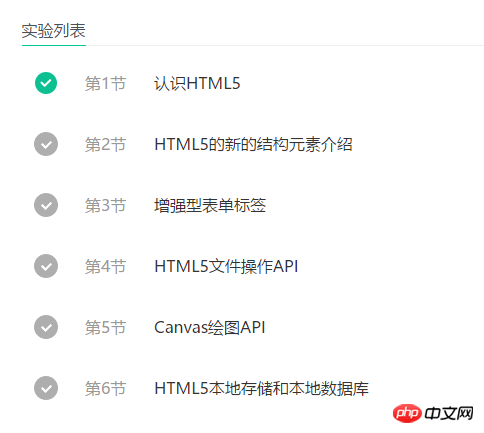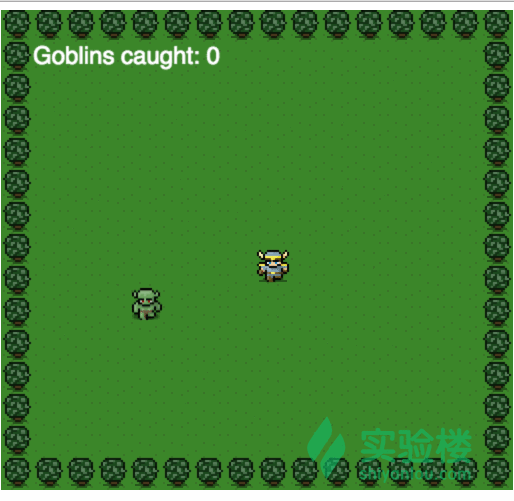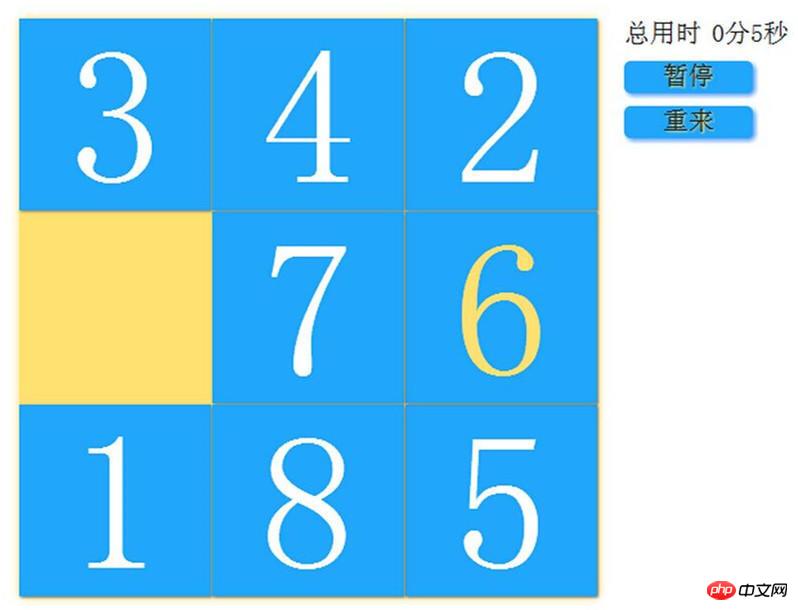1 basic HTML5 introductory tutorial and 4 HTML5 small project tutorials to help you learn HTML5 from scratch.
[HTML5 Basics Introduction]
The tutorial will introduce the new features in HTML5, including structure tags, new form tags, file operations, Canvas, local storage, etc. It is suitable for people who are interested in front-end programming and have already learned HTML.
Experiment list:

[Realize local image cropping based on HTML5]
This project implements the use of HTML5 canvas technology, combined with HTML5 File API to implement local cropping of images. Through this project, you will learn how to combine HTML5 and JavaScript to write a simple single-page application. The project difficulty is average and suitable for students who are just getting started with front-end. They need to understand cavas and have a basic knowledge of JavaScript.
Rendering:

[Implementing a small game based on HTML5 Canvas]
This project implements a small game based on HTML5 canvas. It focuses on the process of HTML5 game development and things that need to be dealt with in game development. Students who are interested in web game development can practice basic knowledge of HTML5 and JavaScript through this project.
Rendering:

[Based on HTML5 to achieve scratch-off effect]
This project uses HTML5 to complete the scratch-off effect of "scratch-off" . HTML5 is the fifth generation version of HTML and is currently the latest version. At the same time, the project also uses JavaScript related technologies to complete. Learning projects help consolidate front-end knowledge.
Rendering:

[HTML5 two-step implementation of jigsaw puzzle]
This project implements the web version based on HTML+CSS+JavaScript Jigsaw puzzle. HTML5, CSS3 and JavaScript related knowledge will be used during the implementation process. Completing this project can further solidify the basic knowledge of front-end.
Rendering:

Finally:
Want to see more front-ends Tutorial, click here to view it;
To learn the front-end learning path, click here to view it;
The above is the detailed content of Learn HTML5 from scratch. For more information, please follow other related articles on the PHP Chinese website!

Hot AI Tools

Undress AI Tool
Undress images for free

Undresser.AI Undress
AI-powered app for creating realistic nude photos

AI Clothes Remover
Online AI tool for removing clothes from photos.

Clothoff.io
AI clothes remover

Video Face Swap
Swap faces in any video effortlessly with our completely free AI face swap tool!

Hot Article

Hot Tools

Notepad++7.3.1
Easy-to-use and free code editor

SublimeText3 Chinese version
Chinese version, very easy to use

Zend Studio 13.0.1
Powerful PHP integrated development environment

Dreamweaver CS6
Visual web development tools

SublimeText3 Mac version
God-level code editing software (SublimeText3)
 Integrating CSS and JavaScript effectively with HTML5 structure.
Jul 12, 2025 am 03:01 AM
Integrating CSS and JavaScript effectively with HTML5 structure.
Jul 12, 2025 am 03:01 AM
HTML5, CSS and JavaScript should be efficiently combined with semantic tags, reasonable loading order and decoupling design. 1. Use HTML5 semantic tags, such as improving structural clarity and maintainability, which is conducive to SEO and barrier-free access; 2. CSS should be placed in, use external files and split by module to avoid inline styles and delayed loading problems; 3. JavaScript is recommended to be introduced in front, and use defer or async to load asynchronously to avoid blocking rendering; 4. Reduce strong dependence between the three, drive behavior through data-* attributes and class name control status, and improve collaboration efficiency through unified naming specifications. These methods can effectively optimize page performance and collaborate with teams.
 Explaining the HTML5 `` vs `` elements.
Jul 12, 2025 am 03:09 AM
Explaining the HTML5 `` vs `` elements.
Jul 12, 2025 am 03:09 AM
It is a block-level element, suitable for layout; it is an inline element, suitable for wrapping text content. 1. Exclusively occupy a line, width, height and margins can be set, which are often used in structural layout; 2. No line breaks, the size is determined by the content, and is suitable for local text styles or dynamic operations; 3. When choosing, it should be judged based on whether the content needs independent space; 4. It cannot be nested and is not suitable for layout; 5. Priority is given to the use of semantic labels to improve structural clarity and accessibility.
 What are the new input types available in HTML5 forms?
Jul 12, 2025 am 03:07 AM
What are the new input types available in HTML5 forms?
Jul 12, 2025 am 03:07 AM
HTML5introducednewinputtypesthatenhanceformfunctionalityanduserexperiencebyimprovingvalidation,UI,andmobilekeyboardlayouts.1.emailvalidatesemailaddressesandsupportsmultipleentries.2.urlchecksforvalidwebaddressesandtriggersURL-optimizedkeyboards.3.num
 How to access user's current location with the HTML5 Geolocation API?
Jul 13, 2025 am 02:23 AM
How to access user's current location with the HTML5 Geolocation API?
Jul 13, 2025 am 02:23 AM
To get the user's current location, use the HTML5 GeolocationAPI. This API provides information such as latitude and longitude after user authorization. The core method is getCurrentPosition(), which requires successful and error callbacks to be handled; at the same time, pay attention to the HTTPS prerequisite, user authorization mechanism and error code processing. ① Call getCurrentPosition to get the position once, and an error callback will be triggered if it fails; ② The user must authorize it, otherwise it cannot be obtained and may no longer be prompted; ③ Error processing should distinguish between rejection, timeout, location unavailable, etc.; ④ Enable high-precision, set timeout time, etc., and can be configured through the third parameter; ⑤ The online environment must use HTTPS, otherwise it may be restricted by the browser.
 Explain the `async` and `defer` attributes for scripts in HTML5.
Jul 13, 2025 am 03:06 AM
Explain the `async` and `defer` attributes for scripts in HTML5.
Jul 13, 2025 am 03:06 AM
The difference between async and defer is the execution timing of the script. async allows scripts to be downloaded in parallel and executed immediately after downloading, without guaranteeing the execution order; defer executes scripts in order after HTML parsing is completed. Both avoid blocking HTML parsing. Using async is suitable for standalone scripts such as analyzing code; defer is suitable for scenarios where you need to access the DOM or rely on other scripts.
 How to use radio buttons in HTML5?
Jul 21, 2025 am 01:08 AM
How to use radio buttons in HTML5?
Jul 21, 2025 am 01:08 AM
The key to using radio buttons in HTML5 is to understand how they work and correctly organize the code structure. 1. The name attribute of each radio button must be the same to achieve mutually exclusive selection; 2. Use label tags to improve accessibility and click experience; 3. It is recommended to wrap each option in a div or label to enhance structural clarity and style control; 4. Set default selections through the checked attribute; 5. The value value should be concise and meaningful, which is convenient for form submission processing; 6. The style can be customized through CSS, but the function needs to be ensured to be normal. Mastering these key points can effectively avoid common problems and improve the effectiveness of use.
 Differentiating HTML5 localStorage and sessionStorage
Jul 15, 2025 am 03:12 AM
Differentiating HTML5 localStorage and sessionStorage
Jul 15, 2025 am 03:12 AM
The core difference between localStorage and sessionStorage lies in data persistence and scope. 1. Data life cycle: localStorage data is stored for a long time unless manually cleared, and sessionStorage data is cleared after closing the tab; 2. Scope difference: localStorage is shared among all tabs on the same website, and sessionStorage is stored independently; 3. Usage scenario: localStorage is suitable for saving long-term data such as user preferences and login status, sessionStorage is suitable for temporary form data or single session process; 4. API consistency: two operation methods
 Is the tag still used in HTML5?
Jul 21, 2025 am 02:47 AM
Is the tag still used in HTML5?
Jul 21, 2025 am 02:47 AM
Yes, it is part of HTML5, but its use has gradually decreased and is controversial. Used to combine the main title with the subtitle so that only the highest level of titles are identified in the document outline; for example, the main title and subtitle can be wrapped in to indicate that they are only auxiliary titles rather than independent chapter titles; however, reasons why they are no longer widely used include: 1. The browser and screen readers are inconsistent support for them, 2. There are simpler alternatives such as using CSS to control styles, 3. The HTML document outline algorithm is not widely supported; despite this, it can still be considered in websites or documents with high semantic requirements; while in most cases, developers tend to use a single, manage styles through CSS and maintain clear title levels.






